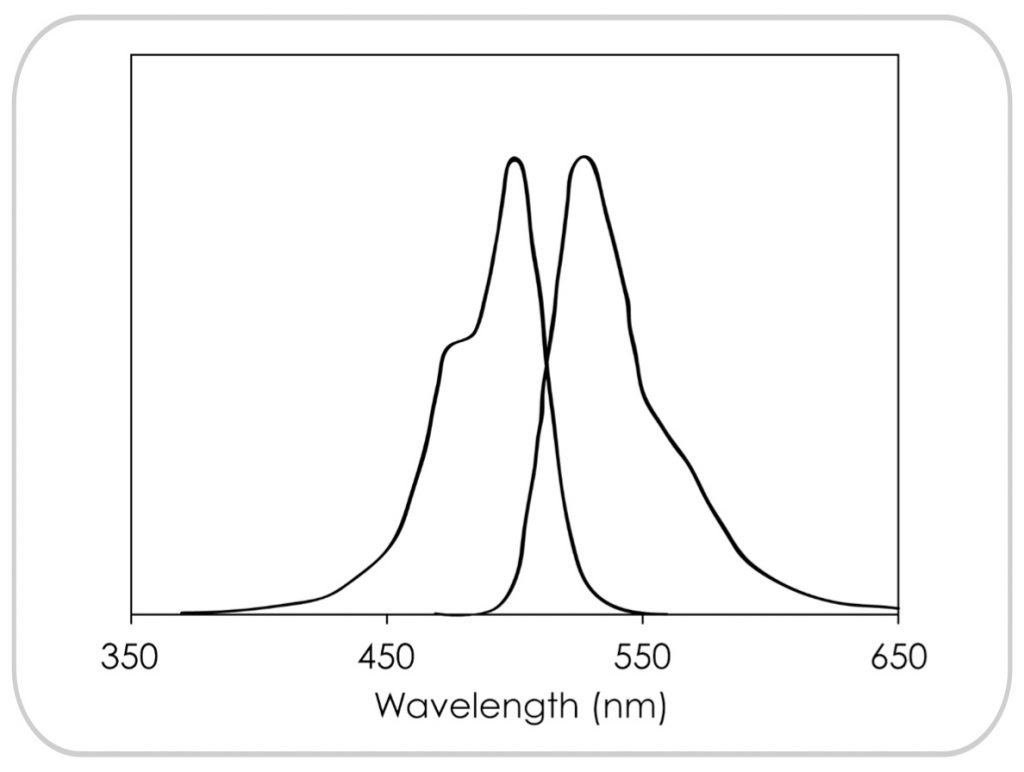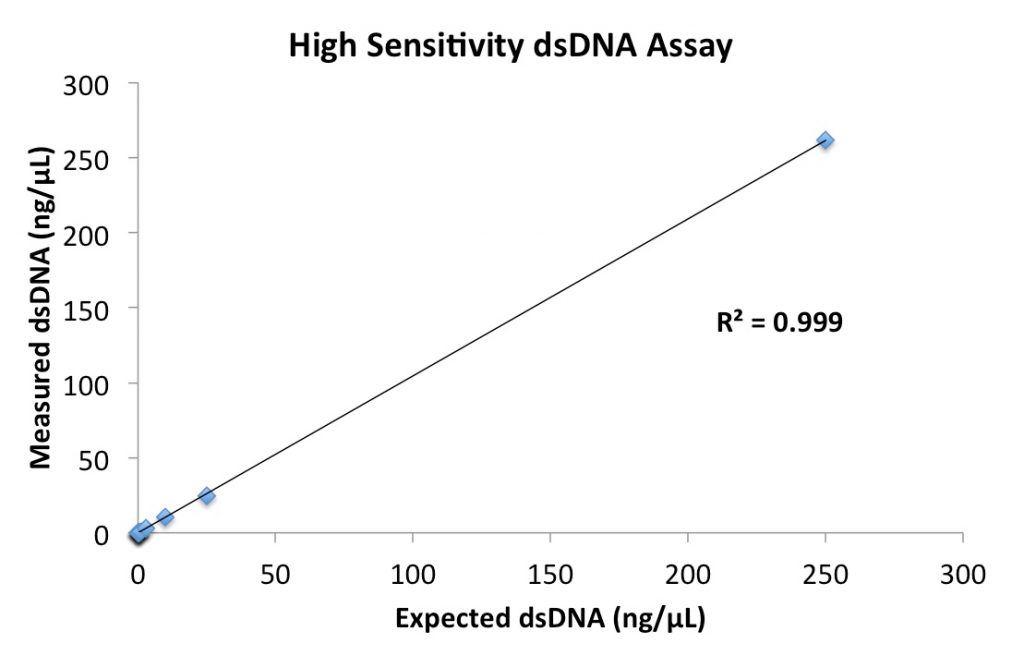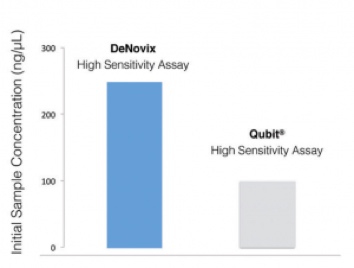Introduction
DeNovix Fluorescence Assays enable dsDNA quantitation over a broad range of concentrations through the use of three distinct fluorescence assay kits.
The DeNovix dsDNA High Sensitivity Assay dye selectively binds dsDNA over RNA, ssDNA or protein. This assay is used to measure samples with concentrations ranging between 5 pg/µL – 250 ng/µL.
The assay dye is designed for use with fluorometers and fluorescence microplate readers equipped with excitation and emission filters for detecting green fluorescence. The DeNovix dye has an excitation maximum at 470 nm and emission maxima at 514 – 567 nm. The excitation and emission spectra are shown in Figure 1.
This technical note presents typical performance data for the measurement range of the DeNovix dsDNA High Sensitivity Assay measured on a DeNovix DS-11 FX Fluorometer.
Materials and Methods
A series of dilutions of calf thymus dsDNA was prepared in TE buffer. The assay working solution was prepared by mixing 10 mL of the assay buffer with 100 µL of the dye.
For each sample, 190 µL of the working solution was added to a thin-walled, clear UV-transparent 0.5 mL PCR tube (DeNovix cat #TUBE-PCR-0.5-500). 10 μL of dsDNA was added to each tube for samples with concentrations between 0.01 and 25 ng/μL. For the lower concentration samples, the volumes were adjusted to 180 μl working solution and 20 μL of dsDNA. For higher concentration samples, 1 μL dsDNA was added to 199 μL working solution.
Reaction solutions were mixed and incubated at room temperature for 5 minutes. Three replicates of each sample were then measured on three separate DeNovix DS-11 FX instruments.
Linearity
The linear response of measured dsDNA and expected concentration of dsDNA measured by the DeNovix High Sensitivity Assay is presented below in Figure 2.
Performance Results
The calculated concentrations of dsDNA measured through the full range of the DeNovix High Sensitivity Assay are shown in Table 1.
The data presented in Table 1 and graphically represented in Figure 2 demonstrate that the DeNovix dsDNA High Sensitivity Fluorescence Assay enables measurement of dsDNA through a range of 5 pg/μL to 250 ng/μL.
The dsDNA concentration range was extended down to 5 pg/μL by adding 20 μL of dsDNA to 180 μL working solution.
Table 1: DeNovix dsDNA High Sensitivity Assay Results Measured on a DeNovix DS-11 FX| Expected dsDNA | Measured dsDNA | |
|---|---|---|
| ng/μL | ng/μL | StDev |
| 0.005 | 0.004 | 0.0002 |
| 0.01 | 0.005 | 0.0001 |
| 0.03 | 0.019 | 0.0000 |
| 0.1 | 0.070 | 0.0000 |
| 0.3 | 0.245 | 0.0004 |
| 1 | 0.790 | 0.0008 |
| 3 | 3.04 | 0.006 |
| 10 | 10.57 | 0.038 |
| 25 | 24.78 | 0.004 |
| 250 | 261.62 | 0.017 |
Competitive Advantage
The DeNovix High Sensitivity Assay has a wider dynamic range than the comparable Thermo Fisher Qubit™ high sensitivity assay. Figure 3 below represents the high concentration range advantage of the DeNovix High Sensitivity Assay as compared to the Thermo Fisher Qubit™ assay.
Summary
The DeNovix dsDNA High Sensitivity Assay enables specific, highly sensitive dsDNA quantification across a wide dynamic range with a simple mix and measure protocol.
If the High Sensitivity Assay does not cover the concentration range of your samples, consider using one of the alternate DeNovix dsDNA assay kits listed in Table 2.
| DeNovix Fluorescence Assay | Range |
|---|---|
| dsDNA Broad Range | 0.1 – 2000 ng/µL |
| dsDNA High Sensitvity | 5 pg/µL – 250 ng/µL |
| dsDNA Ultra High Sensitivity | 0.5 – 300 pg/µL |
| RNA Assay | 0.25 - 1500 ng/µL |
Qubit™ is a registered trademark of Thermo Fisher Scientific and its subsidiaries and is used for identification and references purposes only. DeNovix, DeNovix products and this website are not endorsed by Thermo Fisher Scientific.
Revised 25 Jan 2022






